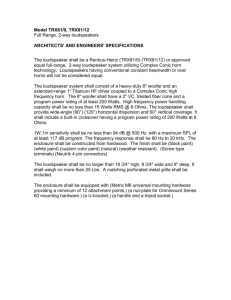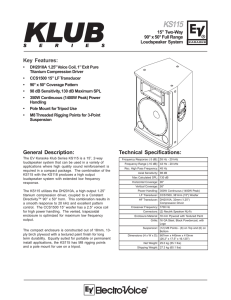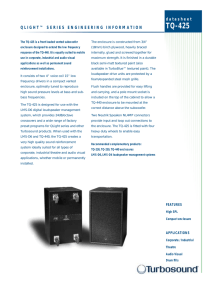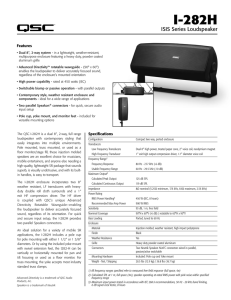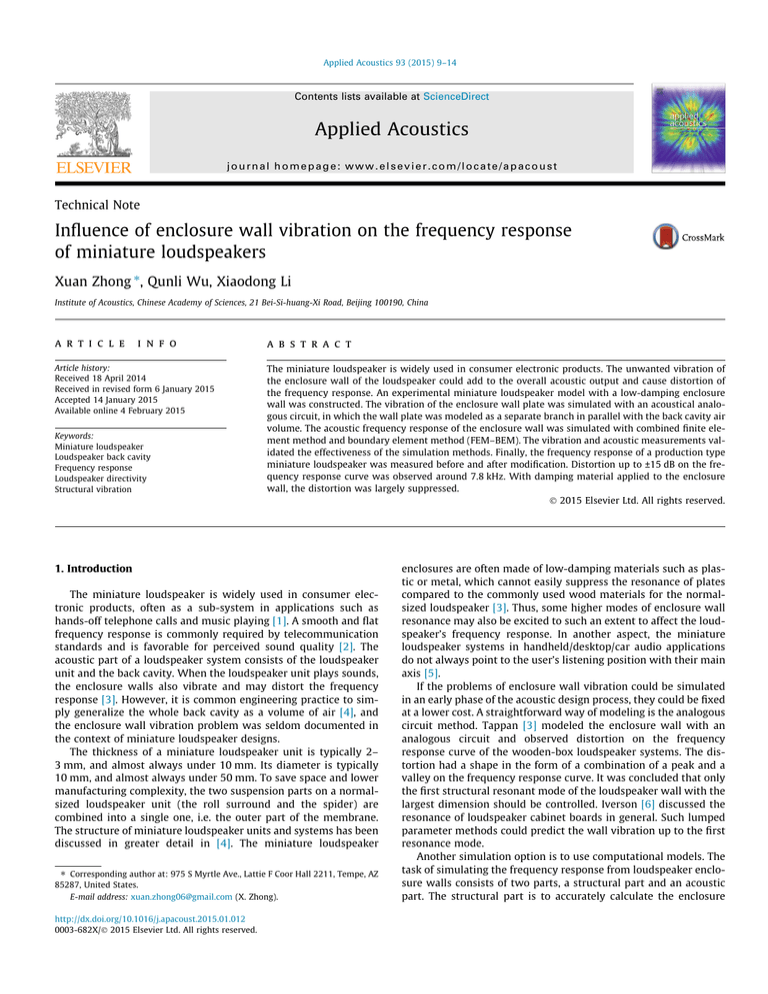
Applied Acoustics 93 (2015) 9–14
Contents lists available at ScienceDirect
Applied Acoustics
journal homepage: www.elsevier.com/locate/apacoust
Technical Note
Influence of enclosure wall vibration on the frequency response
of miniature loudspeakers
Xuan Zhong ⇑, Qunli Wu, Xiaodong Li
Institute of Acoustics, Chinese Academy of Sciences, 21 Bei-Si-huang-Xi Road, Beijing 100190, China
a r t i c l e
i n f o
Article history:
Received 18 April 2014
Received in revised form 6 January 2015
Accepted 14 January 2015
Available online 4 February 2015
Keywords:
Miniature loudspeaker
Loudspeaker back cavity
Frequency response
Loudspeaker directivity
Structural vibration
a b s t r a c t
The miniature loudspeaker is widely used in consumer electronic products. The unwanted vibration of
the enclosure wall of the loudspeaker could add to the overall acoustic output and cause distortion of
the frequency response. An experimental miniature loudspeaker model with a low-damping enclosure
wall was constructed. The vibration of the enclosure wall plate was simulated with an acoustical analogous circuit, in which the wall plate was modeled as a separate branch in parallel with the back cavity air
volume. The acoustic frequency response of the enclosure wall was simulated with combined finite element method and boundary element method (FEM–BEM). The vibration and acoustic measurements validated the effectiveness of the simulation methods. Finally, the frequency response of a production type
miniature loudspeaker was measured before and after modification. Distortion up to ±15 dB on the frequency response curve was observed around 7.8 kHz. With damping material applied to the enclosure
wall, the distortion was largely suppressed.
Ó 2015 Elsevier Ltd. All rights reserved.
1. Introduction
The miniature loudspeaker is widely used in consumer electronic products, often as a sub-system in applications such as
hands-off telephone calls and music playing [1]. A smooth and flat
frequency response is commonly required by telecommunication
standards and is favorable for perceived sound quality [2]. The
acoustic part of a loudspeaker system consists of the loudspeaker
unit and the back cavity. When the loudspeaker unit plays sounds,
the enclosure walls also vibrate and may distort the frequency
response [3]. However, it is common engineering practice to simply generalize the whole back cavity as a volume of air [4], and
the enclosure wall vibration problem was seldom documented in
the context of miniature loudspeaker designs.
The thickness of a miniature loudspeaker unit is typically 2–
3 mm, and almost always under 10 mm. Its diameter is typically
10 mm, and almost always under 50 mm. To save space and lower
manufacturing complexity, the two suspension parts on a normalsized loudspeaker unit (the roll surround and the spider) are
combined into a single one, i.e. the outer part of the membrane.
The structure of miniature loudspeaker units and systems has been
discussed in greater detail in [4]. The miniature loudspeaker
⇑ Corresponding author at: 975 S Myrtle Ave., Lattie F Coor Hall 2211, Tempe, AZ
85287, United States.
E-mail address: xuan.zhong06@gmail.com (X. Zhong).
http://dx.doi.org/10.1016/j.apacoust.2015.01.012
0003-682X/Ó 2015 Elsevier Ltd. All rights reserved.
enclosures are often made of low-damping materials such as plastic or metal, which cannot easily suppress the resonance of plates
compared to the commonly used wood materials for the normalsized loudspeaker [3]. Thus, some higher modes of enclosure wall
resonance may also be excited to such an extent to affect the loudspeaker’s frequency response. In another aspect, the miniature
loudspeaker systems in handheld/desktop/car audio applications
do not always point to the user’s listening position with their main
axis [5].
If the problems of enclosure wall vibration could be simulated
in an early phase of the acoustic design process, they could be fixed
at a lower cost. A straightforward way of modeling is the analogous
circuit method. Tappan [3] modeled the enclosure wall with an
analogous circuit and observed distortion on the frequency
response curve of the wooden-box loudspeaker systems. The distortion had a shape in the form of a combination of a peak and a
valley on the frequency response curve. It was concluded that only
the first structural resonant mode of the loudspeaker wall with the
largest dimension should be controlled. Iverson [6] discussed the
resonance of loudspeaker cabinet boards in general. Such lumped
parameter methods could predict the wall vibration up to the first
resonance mode.
Another simulation option is to use computational models. The
task of simulating the frequency response from loudspeaker enclosure walls consists of two parts, a structural part and an acoustic
part. The structural part is to accurately calculate the enclosure
10
X. Zhong et al. / Applied Acoustics 93 (2015) 9–14
wall vibration based on the parameters of the loudspeaker unit, the
back cavity and the wall structures. Historically, with the finite element method (FEM), Karjalainen et al. [7] measured and simulated,
the vibration of the loudspeaker enclosure walls, but did not calculate the frequency response. So the problem of the second acoustic
part is, given the vibration pattern, how to calculate the acoustic
response at a certain point in the sound field. Bastyr and Capone
[8] measured the enclosure wall vibration with a laser vibrometer.
Based on the measurement, they predicted the acoustic radiation
from loudspeaker enclosure walls with the boundary element
method (BEM) with success. But they did not attempted modeling
the back cavity and the enclosure wall itself. The structural and
acoustic simulations were seldom discussed together in the simulation of enclosure walls, so a more complete study based on an
integrated model is needed.
The current study investigated the influence of loudspeaker
wall vibration on the frequency response of the miniature loudspeaker systems. Both an analogous circuit model and a FEM–
BEM model were used to calculate the enclosure wall vibration
and the acoustic frequency response. Simulations were validated
with the vibration measurement and the acoustic frequency
response measurement. Finally, a real design model of a production type loudspeaker was measured before and after modifications of the enclosure wall to show how the distortion could be
reduced.
2. Theory and calculation
An experimental loudspeaker model was constructed as shown
in Fig. 1. A miniature loudspeaker unit was mounted at the front of
the model. The front and side enclosure walls were made of 5 mm
thick steel which can be considered as a rigid boundary in the
model. A 5 mm deep back cavity was left open at the back side
with clamps on all the edges. The back enclosure wall was a
31 mm ⁄ 31 mm ⁄ 0.34 mm aluminum plate mounted with the
clamps. The boundary condition could be regarded as clamped
on all the four sides of the plate. The acoustic signal measured at
a certain point in the space would be the addition of the sound
from the loudspeaker unit and that from the back enclosure wall.
The main design consideration of the experimental model was
to demonstrate the worst case of enclosure wall vibration. In real
acoustic engineering cases, a square shaped back cavity is often
avoided to reduce the combined modes in the back cavity. However, the outcomes of the research on the simplified model could
still be suggestive of the considerations in actual designs.
2.1. The analogous circuit modeling
The acoustical analogous circuit method combines the electrical, the mechanical and the acoustical parameters of the loudspeaker system in a unified model [9]. The first resonance of the
enclosure wall plate and vibration velocity frequency response of
the plate were simulated. The effect of the back plate vibration
on the vibration of the loudspeaker membrane could also be
derived from the model, as suggested by Tappan [3].
In the model, the electrical and mechanical domains were
reflected to the acoustic domain. As shown in Fig. 2, several groups
of the components were used to represent the three parts of the
experimental model, (a) the loudspeaker unit, (b) the back cavity,
and (c) the enclosure back wall plate.
For the loudspeaker unit branch, the total acoustical impedance
was given by:
Z AS ¼ RAT þ jxM AS þ
1
jxC AS
ð1Þ
where
ZAS – total acoustical impedance of the loudspeaker unit.
RAT – total acoustical resistance of the loudspeaker, including voice
coil resistance and damping of the membrane suspension.
MAS – acoustical mass of the loudspeaker unit.
CAS – acoustical compliance of the loudspeaker unit.
The loudspeaker unit parameters were derived from T–S
parameter measurement [10]. The loudspeaker unit was type Ra
miniature loudspeaker from the former Philips Sound
Solutions (presently a part of Knowles) and its size was
15 mm ⁄ 11 mm ⁄ 3 mm. The parameters of the unit were: the
effective radiation area SD = 2 cm2, force factor Bl = 0.7 T m, CAS =
1.025 ⁄ 1010 m5/N, MAS = 247.4 g/m4, and RAT = 47,430 kg s3/m4.
For the back cavity branch:
Z AB ¼ RAB þ
1
jxC AB
ð2Þ
Listening
Position
Miniature
Loudspeaker Unit
Rigid Front
and Side Walls
Back Cavity
Clamps
Back Enclosure
Wall
Fig. 1. The miniature loudspeaker experimental model under test. The size of the cavity was 31 mm ⁄ 31 mm ⁄ 5 mm.
X. Zhong et al. / Applied Acoustics 93 (2015) 9–14
LOUDSPEAKER UNIT
RAT
C AS
2.2. The BEM–FEM modeling
ENCLOSURE WALL
RAP
M AS
BACK
CAVITY
MAP
CAP
CAB
FEM is commonly used in the prediction of steady-state pressure filed in a confined space volume, whereas BEM is used to calculate sound fields in unbounded spaces based on known vibration
velocities at the boundaries. In contrary to prior work which only
addressed a part of the whole question [7,8], the current study
used a combined FEM–BEM method to simulate the enclosure wall
vibration as well as the acoustic frequency response. The efforts
consisted of two sections:
UP
RAB
Fig. 2. The analogous circuit of a loudspeaker with vibrating enclosure wall plate
(impedance analogy in the acoustic domain). Please refer to Section 2.1 for
definitions of all components.
where
ZAB – total acoustical impedance of the loudspeaker back cavity.
RAB – acoustical resistance in the cabinet.
CAB – acoustical compliance of the air in back cavity.
Here CAB was determined by the back cavity volume, for the current model CAB = 2.682 ⁄ 1011 m5/N. And RAB was determined by
the air and the sound absorptive materials in the cavity [9], in
the present simulation its effect was omitted.
The non-rigid back cavity wall was a plate clamped at all sides.
Past investigations described this branch as follows [11]:
Z AP ¼ RAP þ jxMAP þ
1
jxC AP
ð3Þ
where
ZAP – total acoustical impedance of the enclosure wall plate.
RAP – equivalent acoustical resistance of the enclosure wall
plate.
MAP – equivalent acoustical mass of the enclosure wall plate.
CAP – equivalent acoustical compliance of the enclosure wall plate.
For simple shapes, such as square, rectangular and circular
plates, MAP and CAP could be obtained by analytical methods.
According to the calculation methods described in [12],
MAP = 5053 g/m4 and CAP = 8054 ⁄ 1013 m5/N. In a pilot study RAP
was found to be very small compared to RAT, so in the current study
it was omitted.
Based on the model, the velocity of the enclosure wall plate was
given by:
UP ¼
1
P0
Z AP þ Z AS 1 þ ZZAP
AB
1
jxM AP þ jx1C AP
AP
jxM AP þjxC1
RAT þ jxMAS þ jx1CAS þ
First, the steady state dynamic response of the coupled enclosure wall and back cavity was calculated without considering the
external sound field. The coupling between the air in the back cavity and the enclosure wall was considered. For this purpose, a coupling matrix ensured that the normal fluid displacements in the
back cavity equaled that of the plate of enclosure wall. The vibration pattern of the enclosure wall was calculated. The result was
saved in the form of normal velocity vectors distributed along
the surface of the structural model.
Secondly, the structural model was exported to the BEM simulation environment. The normal velocity distribution on the
boundaries was applied on the BEM model and Green’s functions
were calculated. Finally, the frequency response at any given spatial point of interest could be calculated.
The three dimensional model of the loudspeaker system was
drawn with ANSYS software (version 11.0) and so was the meshing.
Both the FEM and BEM simulations used LMS Sysnoise (version 5.6).
All the modeling and simulation were carried out on a workstation
located in Institute of Acoustics, Chinese Academy of Sciences.
3. Experiments
Acoustical and mechanical measurements demonstrated the
extent of the influence that the enclosure wall vibration has on
the frequency response of miniature loudspeakers [13]. The effectiveness of analogous circuit method and FEM–BEM modeling was
validated by comparing measured data with simulation results.
3.1. Vibration measurement
jxMAP þjxC1
GðjxÞ ¼
(1) Structural simulation (FEM): loudspeaker parameters )
enclosure wall vibration.
(2) Acoustic simulation (BEM): enclosure wall vibration )
acoustic response.
ð4Þ
The resonance of the plate happened when ZAP is at its minimum, which was decided mostly by MAP and CAP. Once the parameters were known, the peak response frequency could be
determined. The normalized transfer function, in its full form,
could be represented as:
1þjxMAP
11
AP
jxMAP þjxC1
1þjxMAP
AP
jxMAP þjxC1
AP
ð5Þ
The analogous circuit model was effective up to the frequency
at which any component in the circuit started to show break-up
modes. In this study the frequency range was under the first
resonant mode of the enclosure wall. A shortcoming of this method
was that lumped parameters of the enclosure walls were not available for irregular shapes.
The velocity of enclosure wall vibration was measured with a
Metrolaser ViroMet 500V laser vibrometer, which emitted a laser
beam targeted at the measurement point on the enclosure wall,
and computed the instantaneous velocity based on the Doppler
Effect. A dot was drawn on the back enclosure wall to facilitate
focusing of the laser beam. The laser vibrometer and the loudspeaker system under test were 30 cm apart. During a test, a frequency sweep signal was generated and played from a B&K
PULSE system. The measured signal from the laser vibrometer
were fed back into the PULSE system and analyzed. A more
detailed explanation of the setup and measurement of the vibrating plates can be found in [13].
3.2. Acoustic frequency response measurement
The half-space frequency response of a miniature loudspeaker
was measured to study how much sound radiated from the back
enclosure wall alone. The test room was a half-space anechoic
chamber located in Institute of Acoustics, Chinese Academy of
12
X. Zhong et al. / Applied Acoustics 93 (2015) 9–14
Sciences (Beijing). The loudspeaker system was mounted on a
100 cm ⁄ 100 cm ⁄ 5 cm wooden board on the ground of the anechoic chamber as shown in Fig. 3. The front side of loudspeaker system faced down toward a pit (70 cm ⁄ 70 cm ⁄ 80 cm) under the
ground of the anechoic chamber. The pit was filled with sound
absorptive materials. The back enclosure wall faced toward the
measurement microphone positioned at 30 cm away. In this way,
the acoustic radiation from the loudspeaker unit and that from
the back enclosure wall were separated.
The measurement transducer was the B&K 4189 pre-polarized
sound field microphone. A B&K PULSE analyzer platform generated
a frequency-sweep signal over the audio frequency range. The electric signal was amplified with type B&K 2716 power amplifier to
drive the loudspeaker system under test with a constant 1 V voltage. The acoustic signals received by the microphone were put
back to the PULSE analyzer platform.
4. Results
Fig. 4. Vibration velocity amplitude (in dB relative to 5 108 m/s) of enclosure
wall, simulated with the analogous circuit method (dotted) and measured with
laser vibrometer.
4.1. Enclosure wall vibration velocity
The vibration velocity of the enclosure wall at low frequencies
was predicted with the analog circuit method as shown in the dotted line in Fig. 4. At around 3 kHz a peak due to enclosure wall
vibration was expected. The simulation generally agrees with the
measurement results of laser vibrometer.
4.2. Frequency response
The half-space acoustic frequency response measurement
showed two peaks at 3 kHz and 10.5 kHz. The simulation of the
loudspeaker enclosure wall were shown together with measurements in Fig. 5. The FEM–BEM model predicted that the (1, 1) mode
was at 3039 Hz (1.3% error) and the combined (1, 3) (3, 1) modes at
11344 Hz (8.0% error). The trend of the frequency response measurement generally agreed with the FEM–BEM simulation.
Fig. 5. Acoustic radiation into the half-space at the backside of the loudspeaker, as
simulated with FEM–BEM model and measured in half-anechoic room.
5. A case study
Although significant distortion was observed in the aforementioned experimental model due to enclosure wall vibrations, a
natural question that arises was whether the same effect was also
Transducer
Half Anechoic Room
Enclosure Wall
30cm
Wood Board
Pit under the Floor
Filled with Sponge
Fig. 3. Measurement of the acoustic radiation from the back enclosure wall. The
test room was a half-space anechoic chamber. Only the acoustic radiation from the
back side of the loudspeaker system was measured by the microphone. The wood
board was 100 cm ⁄ 100 cm ⁄ 5 cm. The pit was 70 cm ⁄ 70 cm ⁄ 80 cm. The figure
is disproportionate and only to demonstrate the test setup.
affecting loudspeaker enclosures of irregular shapes, especially
those in production. To answer this question, an off-the-shelf production type loudspeaker module was measured before and after
modification to the enclosure wall. Loudspeaker modules are combinations of loudspeaker units and enclosures, and are increasingly
widely used in consumer electronics. In acoustic modeling they can
be treated as complete loudspeaker systems.
The dimensions of the loudspeaker module under test was
47 mm ⁄ 12 mm ⁄ 4 mm (Fig. 6). The loudspeaker unit was sealed
in one end of the bar-shaped enclosure. The only sound port was
on the side of the enclosure. The most common listening position,
however, was at a direction directly facing the biggest enclosure
wall instead of the sound port.
The shape of the enclosure was close to a rectangular block. The
analogous circuit method was used for simplicity. It is highly likely
that the effects of the smaller walls, if there were any, was negligible. So only the enclosure wall of the largest dimension (about
47 mm ⁄ 10 mm ⁄ 0.5 mm) was considered. For a rectangular plate
like this, lumped mass and compliance parameters can be calculated easily [12]. Based on the material properties and dimensions,
the first resonant frequency of the biggest enclosure wall was
estimated to be 7500 Hz. A thin layer of high-damping material
was added to the enclosure wall to suppress the vibrations. The
frequency responses were measured before and after this
modification.
X. Zhong et al. / Applied Acoustics 93 (2015) 9–14
13
Fig. 6. The front and back views of the loudspeaker module under test. The dimension of the loudspeaker module was 47 mm ⁄ 12 mm ⁄ 4 mm. The miniature loudspeaker
unit was at one end of the enclosure case. The only sound port was on the side of the module.
The loudspeaker module was tested following procedures that
were close to prior experiments. Without the damping material,
i.e. in the original condition of the loudspeaker module, a typical
distortion of a peak followed by a dip was observed around
7800 Hz (Fig. 7), which largely agrees with the simulation (3.8%
error). The amplitude of the frequency response distortion was
±15 dB. With damping material applied, the distortion was largely
gone. In casual listening tests, the difference between the original
and modified module was clearly audible.
In engineering practice, such a module would eventually be put
into a product, such as a mobile phone case. Some reduction of the
distortion can be expected, but there is no guarantee that the
distortion could be prevented altogether.
70
SPL (dB)
60
50
40
30
Thin Enclosure Wall
Thick Enclosure Wall
20
500
1k
5k
10k
20k
Frequency (Hz)
Fig. 7. The frequency response of the miniature loudspeaker module with original
enclosure wall (real line) and damped enclosure wall (dotted line). A significant
difference was observed around 7800 Hz and was audible.
6. Discussion
In this study, the simulation methods were found to be effective
in the prediction of vibration and acoustic radiation from the
enclosure walls. The analogous circuit method was straightforward
to implement and did not require special software, but could only
predict the vibration velocity of the enclosure wall up to its first
resonant frequency, and was subject to availability of lumped
parameters of the enclosure walls. The combined FEM–BEM modeling, on the other hand, required special software and was more
time-consuming, but it could predict the frequency response in a
larger frequency range, and could easily compute complex shapes
and boundary conditions.
It has been suggested that the higher odd-odd numbered modes
above the first resonance (1, 1) could not alter the frequency
response in a noticeable manner [3]. However, the current study
showed that, in a miniature loudspeaker design, the next highest
odd-odd numbered mode (1, 3) and (3, 1) may also distort the frequency response.
To reduce the influence from the enclosure wall vibration, adding to the thickness and damping of the material was straightforward and effective [3,13]. Changing the materials to laminated
plates would also increase damping and thus reduce the peak
vibration [14]. Adding irregular ribs would increase the resonant
frequency to a region where the acoustic radiation is less effective,
so it may also be a feasible solution [15]. In the case study in Section 5, a production type loudspeaker module was modified with a
thin layer of damping material, and the resonant mode at 7.8 kHz
was effectively suppressed.
The real design cases of miniature loudspeakers differ greatly in
material and dimensions, so the range of the resonance peaks was
hard to define. However, in both the experimental and the
production models, enclosure wall vibrations caused peaks in the
frequency response curve within the audible range. So when
14
X. Zhong et al. / Applied Acoustics 93 (2015) 9–14
reducing the size or the enclosure wall thickness of miniature
loudspeakers, the influence of enclosure wall vibration is an engineering problem that should be addressed carefully.
7. Conclusion
This technical note showed that the frequency response of miniature loudspeaker system could be distorted by the vibration of
enclosure walls. The analogous circuit simulation could predict
the first resonant peak of the enclosure wall for simple shapes
and boundary conditions. The FEM–BEM model, on the other hand,
provided an estimation of all the structural modes that might affect
the frequency response and the extent of the influence.
Acknowledgment
The authors are indebted to Dr. William Yost for proofreading
the manuscript.
References
[1] Huang JH, Her HC, Shiah YC, Shin SJ. Electroacoustic simulation and
experiment on a miniature loudspeaker for cellular phones. J Appl Phys
2008;103(3):033502.
[2] Bahne A. Perceived sound quality of small original and optimized loudspeaker
systems. J Audio Eng Soc 2012;60(1/2):29–37.
[3] Tappan PW. Loudspeaker enclosure walls. J Audio Eng Soc 1962;10(3):224–31.
[4] Bai MR, Liao J. Acoustic analysis and design of miniature loudspeakers for
mobile phones. J Audio Eng Soc 2005;53(11):1061–76.
[5] Schwarz BA, Brinkerhoff DE. Some observations on reproduced sound in an
automobile. J Audio Eng Soc 1958;6(1):58–63.
[6] Iverson JK. The theory of loudspeaker cabinet resonances. J Audio Eng Soc
1973;21(3):177–80.
[7] Karjalainen M, Ikonen V, Antsalo P, Maijala P, Savioja L, Suutala A, et al.
Comparison of numerical simulation models and measured low-frequency
behavior of loudspeaker enclosures. J Audio Eng Soc 2001;49(12):1148–66.
[8] Bastyr KJ, Capone DE. On the acoustic radiation from a loudspeaker’s cabinet. J
Audio Eng Soc 2003;51(4):234–43.
[9] Beranek LL, Mellow T. Acoustics: sound fields and transducers. Academic
Press; 2012.
[10] Small RH. Direct radiator loudspeaker system analysis. J Audio Eng Soc
1972;20(5):383–95.
[11] Frost AD. Analog circuit representation for wall panels. J Acoust Soc Am
2005;28(6):1285–91.
[12] Leissa AW. The free vibration of rectangular plates. J Sound Vib
1973;31(3):257–93.
[13] Zhong X, Wu Q, Li X. Improving acoustical performances of miniature
loudspeaker systems with a laser vibrometer. Audio Eng 2008;32(8):22–5
(in Chinese).
[14] Sun CT, Sankar BV, Rao VS. Damping and vibration control of unidirectional
composite laminates using add-on viscoelastic materials. J Sound Vib
1990;139(2):277–87.
[15] Photiadis DM. The effect of irregularity on the scattering of acoustic waves
from a ribbed plate. J Acoust Soc Am 1992;91(4):1897–903.

